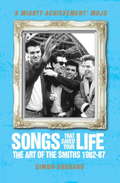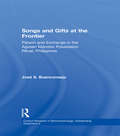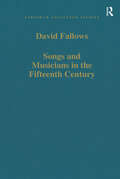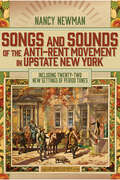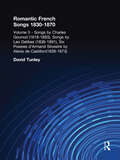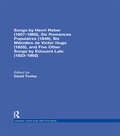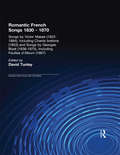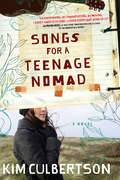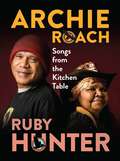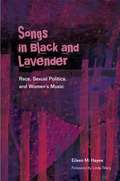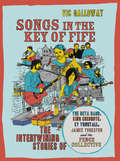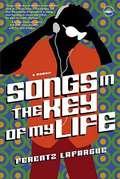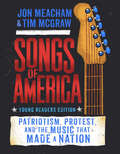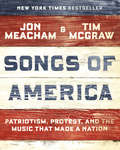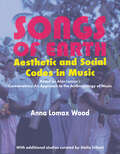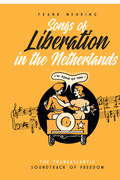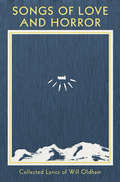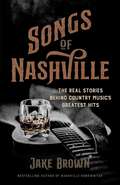- Table View
- List View
Songs That Saved Your Life (Revised Edition)
by Simon GoddardOne of the seminal groups of the Eighties, The Smiths' career was as brilliant as it was brief. Now, drawing on interviews with band members, producers, and colleagues, music journalist Simon Goddard presents a meticulous chronological survey of the group's musical evolution, from their first demos in 1982 to their final fractured studio session five years later. Investigating the stories behind the songs, and detailing every British TV and radio session, he also offers a unique analysis of each track's concert life. Granted unprecedented access to The Smiths' studio archives and to the private collection of outtakes and rehearsals retained by drummer Mike Joyce, the author lifts the lid on unreleased material as well as the lost songs and alternate versions that have remained closely guarded secrets until now.
Songs and Gifts at the Frontier (Current Research in Ethnomusicology: Outstanding Dissertations #4)
by Jose S. BuenconsejoThis book investigates the particular history and social experience by a marginalized society in Mindanao Island, Philippines, through an analysis of the speech, song and dance in spirit possession ritual. Using the concepts of exchange and reciprocity, Buenconsejo connects the performativity of ritual song to the formation and maintenance of sociability, personhood and subjectivity. Also inlcludes maps.
Songs and Musicians in the Fifteenth Century (Variorum Collected Studies)
by David FallowsThe essays in this volume are concerned with song repertories and performance practice in 15th-century Europe. The first group of studies arises from the author's long-term fascination with the widely dispersed traces of English song and , in particular, with the most successful song by any English composer, O rosa bella. This leads to a set of enquiries into the distribution and international currents of the song repertory in Italy and Spain. The essays in the final section, taken together, represent an extended discussion of the problems of performance, both of voice and instrument, what they performed and how.
Songs and Sounds of the Anti-Rent Movement in Upstate New York: Including Twenty-Two New Settings of Period Tunes (SUNY series, An American Region: Studies in the Hudson Valley)
by Nancy NewmanUpstate New York's Anti-Rent Movement is considered the last struggle over feudalism in the United States. Tenant farmers in the Hudson-Mohawk region engaged in organized protest throughout the 1840s to contest monopoly ownership of the land they worked. Arguing their cause in newspapers, on broadsides, and at rallies, their aspirations also took shape in poetry and song. More than twenty sets of lyrics (and one instrumental composition) were written at various stages of the conflict. Some of their musical sources, such as "Old Dan Tucker" and "Bruce's Address," are still well known. Each fully contextualized song offers insight into the role vernacular music played in one of the nineteenth century’s major social reform movements.This is the first book to gather the poetry and corresponding tunes into one publication. It provides detailed analysis of the repertory, followed by new musical scores of the songs, reconstructed from contemporary historical sources for study and performance. It also examines the movement’s later dramatization in novels, film, and public commemorations as successive generations grapple with its meaning.
Songs by Charles Gounod (Romantic French Song 1830-1870 Series)
by David TunleyFirst Published in 1995. Routledge is an imprint of Taylor & Francis, an informa company.
Songs by Charles Gounod (Romantic French Song 1830-1870 Series)
by David TunleyFirst Published in 1995. This series comprises nearly 300 romances and melodies, most of which were composed during the 40 years that saw a blossoming of the romantic spirit in all the arts in France. It brings together some of the most attractive pieces by the best songwriters of the period, and in so doing provides an overview of the development of nineteenth-century French song before Faure, Duparc, and Debussy
Songs by Henri Reber (Romantic French Song 1830-1870 Series #Vol. 3)
by David TunleyFirst Published in 1995. Routledge is an imprint of Taylor & Francis, an informa company.
Songs by Victor Mass (Romantic French Song 1830-1870 Series)
by David TunleyFirst Published in 1995. This title is volume 4 in a series comprising nearly 300 romances and mélodies, most of which were composed during the 40 years that saw a blossoming of the romantic spirit in all the arts in France. The composers represented in this volume were of a rather serious turn of musical mind and many of the songs presented seem to have enjoyed the more sheltered success of the private recital to which the critics may not have been invited.
Songs for a Teenage Nomad
by Kim Culbertson"So engrossing, so transporting, so moving, I didn't want it to end! A beautiful, lyrical read-I loved every last word of it!" -Alyson Noeuml;l, #1 New York Times Bestselling Author of The Immortals series What is the soundtrack of your life? After living in twelve places in eight years, Calle Smith finds herself in Andreas Bay, California, at the start of ninth grade. Another new home, another new school. . . Calle knows better than to put down roots. Her song journal keeps her moving to her own soundtrack, bouncing through a world best kept at a distance. Yet before she knows it, friends creep in-as does an unlikely boy with a secret. Calle is torn over what may be her first chance at love. With all that she's hiding and all that she wants, can she find something lasting beyond music? And will she ever discover why she and her mother have been running in the first place? "Songs for a Teenage Nomad will send you searching for songs with meaning for the major events of your own life. " -Cindy Hudson, author of Book by Book: The Complete Guide to Creating Mother-Daughter Book Clubs. "The best kind of song takes you on a roller coaster ride of emotions. It makes you think. You find yourself humming and pondering it for days. Songs for a Teenage Nomad does the book version of this. It's an unforgettable story that music lovers in particular will appreciate, but every teenager trying to find their place in the world should read. " -Stephanie Kuehnert, author of I Wanna Be Your Joey Ramone and Ballads of Suburbia
Songs for the Spirits: Music and Mediums in Modern Vietnam
by Barley NortonSongs for the Spirits examines the Vietnamese practice of communing with spirits through music and performance. During rituals dedicated to a pantheon of indigenous spirits, musicians perform an elaborate sequence of songs--a "songscape"--for possessed mediums who carry out ritual actions, distribute blessed gifts to disciples, and dance to the music's infectious rhythms. Condemned by French authorities in the colonial period and prohibited by the Vietnamese Communist Party in the late 1950s, mediumship practices have undergone a strong resurgence since the early 1990s, and they are now being drawn upon to promote national identity and cultural heritage through folklorized performances of rituals on the national and international stage. By tracing the historical trajectory of traditional music and religion since the early twentieth century, this groundbreaking study offers an intriguing account of the political transformation and modernization of cultural practices over a period of dramatic and often turbulent transition. An accompanying DVD contains numerous video and music extracts that illustrate the fascinating ways in which music evokes the embodied presence of spirits and their gender and ethnic identities.
Songs from Scripture (LifeGuide Bible Studies)
by James W. Reapsome"Sing praises to God, sing praises; sing praises unto our King, sing praises. For God is King of all the earth; sing ye praises with understanding," (Psalm 47:6-7). Throughout the Bible there are songs. Some are songs of celebration and hope while others express despair or humility and still others recount God's redemption. "Songs lift our hearts and minds," writes James Reapsome. "They powerfully convey truth poetically and musically. God commands us to love him totally and exclusively with the union of our emotion, intellect, and will. That's why he included songs when he inspired the words of the Bible." Taken together these songs reveal our humanity before God and the glory and grace of life in him. This nine-session LifeGuide Bible Study explores several biblical songs from both the Old and New Testaments. For over three decades LifeGuide Bible Studies have provided solid biblical content and raised thought-provoking questions—making for a one-of-a-kind Bible study experience for individuals and groups. This series has more than 130 titles on Old and New Testament books, character studies, and topical studies.
Songs from Sweden: Shaping Pop Culture in a Globalized Music Industry (Geographies of Media)
by Ola JohanssonSongs from Sweden shows how Swedish songwriters and producers are the creative forces behind much of today’s international pop music. As Ola Johansson reveals, the roots of this “music miracle” can be found in Sweden’s culture, economy, and thriving music industry, concentrated in Stockholm. While Swedish writer-producers developed early global recognition for making commercially successful pop music, new Swedish writer-producers have continuously emerged during the last two decades. Global artists travel to Stockholm to negotiate, record, and co-write songs. At the same time, Swedish writer-producers are part of a global collaborative network that spans the world. In addition to concrete commercial accomplishments, the Swedish success is also a result of the acquisition of reputational capital gained through positive associations that the global music industry holds about Swedish music. Ultimately, pop songs from Sweden exhibit a form of cultural hybridity, drawing from both local and global cultural expressions.
Songs from the Edge of Japan: Music-making In Yaeyama And Okinawa (epu (SOAS Studies in Music Series)
by Matt GillanSince the early 1990s, Okinawan music has experienced an extraordinary boom in popularity throughout Japan. Musicians from this island prefecture in the very south of Japan have found success as performers and recording artists, and have been featured in a number of hit films and television dramas. In particular, the Yaeyama region in the south of Okinawa has long been known as a region rich in performing arts, and Yaeyaman musicians such as BEGIN, Daiku Tetsuhiro, and Natsukawa Rimi have been at the forefront of the recent Okinawan music boom. This popularity of Okinawan music represents only the surface of a diverse and thriving musical culture within modern-day Yaeyama. Traditional music continues to be an important component of traditional ritual and social life in the islands, while Yaeyama's unique geographical and cultural position at the very edge of Japan have produced varied discourses surrounding issues such as tradition versus modernity, preservation, and cultural identity. Songs from the Edge of Japan explores some of the reasons for the high profile of Yaeyaman music in recent years, both inside and outside Yaeyama. Drawing on extensive ethnographic fieldwork carried out since 2000, the book uses interviews, articles from the popular media, musical and lyrical analysis of field and commercial recordings, as well as the author's experiences as a performer of Yaeyaman and Okinawan music, to paint a picture of what it means to perform Yaeyaman music in the 21st century.
Songs from the Kitchen Table: Lyrics and Stories
by Archie Roach Ruby HunterThe ultimate illustrated commemoration of iconic Australian musicians Archie Roach and Ruby Hunter in songs, stories, photographs and tributes. Since he left us, Archie Roach&’s legacy has continued to soar, like his totem animal from his mother&’s ancestral lands, the wedge-tailed eagle. Archie&’s songs stand as anthems for both the experience of dispossession and our shared humanity.Songs from the Kitchen Table is a tribute to the power of Archie&’s voice, and to the love of music he shared with his life partner and musical collaborator, Ruby Hunter. This beautiful, illustrated volume contains the lyrics to over one hundred of their songs, carefully curated by Archie&’s manager and friend, Jill Shelton. From Archie&’s breathtaking early works, &‘Took the Children Away&’ and &‘Charcoal Lane&’, to the timeless classics &‘Tell Me Why&’, Ruby&’s &‘Down City Streets&’, and Archie&’s final masterpiece, &‘One Song&’, the lyrics are accompanied by stories about their composition, rare photographs, original artwork, and heartfelt tributes to Archie and Ruby from those who knew and loved them. With forewords by their long-time friends and musical collaborators, Emma Donovan, Paul Kelly and Jack Latimore, Songs from the Kitchen Table is a celebration of one of Australia&’s great creative partnerships, and a testament to the ongoing power of plain-spoken truths.
Songs in Black and Lavender: Race, Sexual Politics, and Women's Music
by Eileen M. Hayes Linda TilleryDrawing on fieldwork conducted at eight women's music festivals, Eileen M. Hayes shows how studying these festivals--attended by predominately white lesbians--provides critical insight into the role of music and lesbian community formation. She argues that the women's music festival is a significant institutional site for the emergence of black feminist consciousness in the contemporary period. Hayes also offers sage perspectives on black women's involvement in the women's music festival scene, the ramifications of their performances as drag kings in those environments, and the challenges and joys of a black lesbian retreat based on the feminist festival model. With acuity and candor, longtime feminist activist Hayes elucidates why this music scene matters. Veteran vocalist, percussionist, producer, and cultural historian Linda Tillery provides a foreword.
Songs in the Key of Black Life: A Rhythm and Blues Nation
by Mark Anthony NealIn Songs in the Key of Black Life, acclaimed cultural critic Mark Anthony Neal turns his attention to Rhythm and Blues. He argues that R&B-often dismissed as just a bunch of love songs, yet the second most popular genre in terms of sales-can tell us much about the dynamic joys, apprehensions, tensions, and contradictions of contemporary black life, if we listen closely. With a voice as heartfelt and compelling as the best music, Neal guides us through the work of classic and contemporary artists ranging from Marvin Gaye to Macy Gray. In the first section of the book, Rhythm, he uses the music of Meshell N'degeocello, Patti Labelle, Jill Scott, Alicia Keys, and others as guideposts to the major concerns of contemporary black life-issues such as gender, feminist politics, political activism, black masculinity, celebrity, and the fluidity of racial and sexual identity. The second part of the book, Blues, uses the improvisational rhythms of black music as a metaphor to examine currents in black life including the public dispute between Cornel West and Harvard President Lawrence Summers and the firing of BET's talk-show host Tavis Smiley. Songs in the Key of Black Life is a remarkable contribution to the study of black popular music, and valuable reading for anyone interested in how race is lived in America.
Songs in the Key of Fife: The Intertwining Stories of the Beta Band, King Creosote, KT Tunstall, James Yorkston and the Fence Collective
by Vic GallowayA look at the careers of several acclaimed Scottish musicians from Fife, from their early days to the highs and lows of the music industry, to today. The East Neuk of Fife, Scotland, may seem like an unusual place for a musical revolution, but as this firsthand account reveals, there is more to the sleepy fishing villages and rolling fields, and a small community of musicians has crept up on the world. From psychedelic troubadours the Beta Band to the Billboard chart star KT Tunstall, acclaimed singer-songwriter James Yorkston, and the reigning monarch and lynchpin of the Fence Collective, King Creosote, this book plots the unique, intertwining tales of these Fifers from their schooldays to the present day. This story, full of personal anecdotes and exclusive interviews, provides an in-depth look at a unique collective of musicians who have experienced the extreme highs and the desperate lows of the music business and how a craggy outpost on the east coast of Scotland had a role in crafting talented artists.Praise for Songs in the Key of Fife&“DJ turned author Galloway does a superb job of documenting the lives of these artists, misfits and &“heads,&” not least because he is a Fife lad himself.&” —Mojo (UK)&“A remarkable insight into the pitfalls of the music industry . . . essential reading for any young musician in Scotland thinking about trying to make a go of it—not least for the rude awakening it may offer before their dreams are shattered. But it also shows how success can be achieved against seemingly insurmountable odds.&” —The Scotsman (UK)
Songs in the Key of My Life: A Memoir
by Ferentz Lafargue"Music is a world within itself, with a language we all understand. " --Stevie Wonder, "Sir Duke." In 2003, young professor Ferentz LaFargue traveled to Paris, where his fiancée, Tricia, declared she wasn't happy with their relationship, ending what he thought was a wonderful engagement. After days of "craying"--"that sorrow-laden blend of crying and praying delivered in perfect pitch by those in mourning"--Ferentz happened upon Stevie Wonder's 1976 classic double album Songs in the Key of Life. Listening to it anew was a healing, spiritual trip down memory lane, helping him to come to terms with his breakup and reflect on how songs in general have been linked to his life. In this book, Ferentz invites us to get cozy and listen as he hits PLAY on meaningful tracks from Wonder and others, including Lauryn Hill, Wyclef Jean, LL Cool J, Beenie Man, Sheryl Crow, Roberta Flack, Donny Hathaway, and Black Sabbath. He recalls: How the fusion of rock and rap in the breakthrough Run-D. M. C. /Aerosmith video "Walk This Way" helped to change an adolescent Ferentz from outcast to authority figure How Michael Jackson'sThriller brought back a traumatic childhood experience How Kanye West's "Jesus Walks" speaks to the tension between his Christian beliefs and his need to rip it up in clubs as a hip-hop head In the tradition of Nick Hornby's Songbook¸ these words paint a portrait of a life framed by sounds, allowing all of us to think about what songs have been key in our own lives.
Songs in the Key of Z: The Curious Universe of Outsider Music
by Irwin ChusidOutsider musicians can be the product of damaged DNA, alien abduction, drug fry, demonic possession, or simply sheer obliviousness. This book profiles dozens of outsider musicians, both prominent and obscure--figures such as The Shaggs, Syd Barrett, Tiny Tim, Jandek, Captain Beefheart, Daniel Johnston, Harry Partch, and The Legendary Stardust Cowboy--and presents their strange life stories along with photographs, interviews, cartoons, and discographies. About the only things these self-taught artists have in common are an utter lack of conventional tunefulness and an overabundance of earnestness and passion. But, believe it or not, they're worth listening to, often outmatching all contenders for inventiveness and originality.A CD featuring songs by artists profiled in the book is also available.
Songs of America: Patriotism, Protest, and the Music That Made a Nation
by Jon Meacham Tim McGrawAn adaptation for young readers of the outstanding adult bestseller by Pulitzer Prize–winning writer Jon Meacham and Grammy Award–winning artist Tim McGraw celebrating America and the music that shaped it.Songs of America explores the music of important times in our history—the stirring pro- and anti-war music of the Revolutionary and Civil Wars, World Wars I and II, and the Vietnam War; the folk songs and popular music of the Great Depression, the fight for women&’s rights, and the Civil Rights movement; and the music of both beloved and lesser-known poets, musicians, and songwriters from Colonial times to the twenty-first century. Pulitzer Prize–winning author Jon Meacham and Grammy Award–winning artist Tim McGraw present the songs of patriotism and protest that gave voice to the politicians and activists who moved the country forward, seeking to fulfill America&’s destiny as the land of liberty and justice for all. Readers will recognize pages from the American songbook—examples include &“The Star-Spangled Banner,&” &“The Battle Hymn of the Republic,&” &“We Shall Overcome,&” and &“Born in the U.S.A.&”—and will be introduced to lesser-known but equally important works that have inspired Americans to hold on to the tenets of freedom at the roots of our nation. Adapted from the adult bestseller, Songs of America: Young Readers Edition highlights the unique role music has played in uniting and shaping a nation.
Songs of America: Patriotism, Protest, and the Music That Made a Nation
by Jon Meacham Tim McGrawThrough all the years of strife and triumph, America has been shaped not just by our elected leaders and our formal politics but also by our music—by the lyrics, performers, and instrumentals that have helped to carry us through the dark days and to celebrate the bright ones. <P><P>From “The Star-Spangled Banner” to “Born in the U.S.A.,” Jon Meacham and Tim McGraw take readers on a moving and insightful journey through eras in American history and the songs and performers that inspired us. <P><P>Meacham chronicles our history, exploring the stories behind the songs, and Tim McGraw reflects on them as an artist and performer. Their perspectives combine to create a unique view of the role music has played in uniting and shaping a nation. Beginning with the battle hymns of the revolution, and taking us through songs from the defining events of the Civil War, the fight for women’s suffrage, the two world wars, the Great Depression, the civil rights movement, the Vietnam War, and into the twenty-first century, Meacham and McGraw explore the songs that defined generations, and the cultural and political climates that produced them. <P><P>Readers will discover the power of music in the lives of figures such as Harriet Tubman, Franklin Roosevelt, Eleanor Roosevelt, and Martin Luther King, Jr., and will learn more about some of our most beloved musicians and performers, including Marian Anderson, Elvis Presley, Sam Cooke, Aretha Franklin, Bob Dylan, Duke Ellington, Carole King, Bruce Springsteen, and more.Songs of America explores both famous songs and lesser-known ones, expanding our understanding of the scope of American music and lending deeper meaning to the historical context of such songs as “My Country, ’Tis of Thee,” “God Bless America,” “Over There,” “We Shall Overcome,” and “Blowin’ in the Wind.” As Quincy Jones says, Meacham and McGraw have “convened a concert in Songs of America,” one that reminds us of who we are, where we’ve been, and what we, at our best, can be. <P><b>A New York Times Bestseller</b>
Songs of Earth: Aesthetic and Social Codes in Music
by Anna L. WoodBased upon Cantometrics: An Approach to the Anthropology of Music (1976), by Alan Lomax, Songs of Earth: Aesthetic and Social Codes in Music is a contemporary guide to understanding and exploring Cantometrics, the system developed by Lomax and Victor Grauer for analyzing the formal elements of music related to human geography and sociocultural patterning. This carefully constructed cross-cultural study of world music revealed deep-rooted performance patterns and aesthetic preferences and their links with environmental factors and ancient socioeconomic practices. This new and updated edition is for anyone wishing to understand and more deeply appreciate the forms and sociocultural contexts of the musics of the world’s peoples, and it is designed to be used by both scholars and laypeople.Part One of the book consists of a practical guide to using the Cantometrics system, a course with musical examples to test one’s understanding of the material, a theoretical framework to put the methodology in context, and an illustration of the method used to explore the roots of popular music. Part Two includes guides to four other analytical systems that Lomax developed, which focus on orchestration, phrasing and breath management, vowel articulation, instrumentation, and American popular music. Part Three provides resources for educators who wish to use the Cantometrics system in their classrooms, a summary of the findings and hypotheses of Lomax’s original research, and a discussion of Cantometrics’ criticisms, applications, and new approaches, and it includes excerpts of Lomax’s original writings about world song style and cultural equity.
Songs of Liberation in the Netherlands: The Transatlantic Soundtrack of Freedom
by Hugo JanWhen the Allied Forces arrived in the Netherlands after Operation Market Garden, the country's long-awaited liberation from National Socialist occupation finally came in the summer of 1945. With freedom reclaimed, a wave of joy and hope swept through the nation, finding its most powerful expression in the stirring liberation songs that resonated across the land. These songs, an evocative transatlantic soundtrack of freedom, captured the spirit of the time through music, lyrics, and dance, celebrating the euphoria of a nation reborn. Songs of Liberation in the Netherlands: The Transatlantic Soundtrack of Freedom invites readers on an extraordinary journey into this transformative period. Frank Mehring, along with an international team of writers, musicians, and curators, brings to life the vibrant music that accompanied liberation by drawing from the remarkable Hugo Keesing collection at the Freedom Museum in Groesbeek, featuring over 300 rare sheet songs. Now rediscovered, these songs offer a profound connection to the past, inviting us to reimagine the emotional power of music in shaping cultural memory.
Songs of Love and Horror: Collected Lyrics Of Will Oldham
by Will OldhamThe definitive collection of lyrics from three decades of songwriting. As a performer, songwriter, and actor, Will Oldham has carved a singular path through the worlds of indie folk and cinema. Now the critically acclaimed, enigmatic artist presents his life’s work: the lyrics to more than two hundred songs spanning the 1980s to the present, each with annotations that impart new meaning to his music. Oldham’s aphoristic meditations—on death, patience, and turning carelessness into a virtue—are, like his lyrics, profound, earthy, and often funny. They reveal flashes of Oldham’s philosophy, the sources and circumstances that inspired his lyrics, and the literary ambition of his songwriting. Separated from their aural form, Oldham’s lyrics become a new kind of poetry—candid, awkward, and wise—with influences as diverse as Rabindranath Tagore and The Mekons. A book that will delight his longtime fans and inspire young songwriters, Songs of Love and Horror reveals an artist who has captured extraordinary poetry in music despite being "a stranger among my own language."
Songs of Nashville: The Real Stories Behind Country Music's Greatest Hits
by Jake Brown"Jake Brown puts the songwriter in the spotlight." —Billboard Country Here are the untold stories behind country&’s most influential songs from the tunesmiths themselves—featuring interviews with Jelly Roll, Taylor Swift cowriters Liz Rose and Lori McKenna, Luke Combs cowriter Drew Parker, Morgan Wallen hit writer Josh Thompson, chart-toppers Clint Black and Vince Gill, legends and trendsetters like the late Merle Haggard and Kinky Friedman, Americana troubadour Jim Lauderdale, and song crafters with scores in film and television like A Star Is Born Oscar nominees Hillary Lindsey and Natalie Hemby and Songland judge Shane McAnally.Songs of Nashville is a look inside the lives and work of the artists who&’ve shaped Nashville and the sound of country. It reveals the emotional fuel, melodic and lyrical science, and pure magic of the Music Row hitmaking machine. Through in-depth profiles and conversations, country artists reveal the birth stories of the songs you know and love—and some you may not, but you definitely should!—from spontaneous moments of inspiration to the chemistry of collaboration. Songs of Nashville is a must-read to discover the secrets of the creative process and the enduring power of storytelling that makes country music timeless.
